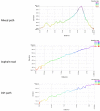Physiological and Perceptual Responses to Nordic Walking in a Natural Mountain Environment
- PMID: 29039775
- PMCID: PMC5664736
- DOI: 10.3390/ijerph14101235
Physiological and Perceptual Responses to Nordic Walking in a Natural Mountain Environment
Abstract
Background: Interest around Nordic Walking (NW) has increased in recent years. However, direct comparisons of NW with normal walking (W), particularly in ecologically valid environments is lacking. The aim of our study was to compare NW and W, over long distances in a natural mountain environment. Methods: Twenty one subjects (13 male/8 female, aged 41 ± 12 years, body mass index BMI 24.1 ± 3.7), walked three distinct uphill paths (length 2.2/3.4/7 km) with (NW) or without (W) walking poles over two separate days. Heart rate (HR), energy expenditure (EE), step length (SL), walking speed (WS), total steps number (SN) and rating of perceived exertion (RPE) were monitored. Results: HR (+18%) and EE (+20%) were higher in NW than in W whilst RPE was similar. SN (-12%) was lower and SL (+15%) longer in NW. WS was higher (1.64 vs. 1.53 m s-1) in NW. Conclusions: Our data confirm that, similarly to previous laboratory studies, differences in a range of walking variables are present between NW and W when performed in a natural environment. NW appears to increase EE compared to W, despite a similar RPE. Thus, NW could be a useful as aerobic training modality for weight control and cardiorespiratory fitness.
Keywords: RPE; energy expenditure; natural environment; pole walking locomotion; trekking.
Conflict of interest statement
The authors declare no conflict of interest.
Figures





Similar articles
-
Physiological response and cardiorespiratory adaptation after a 6-week Nordic Walking training targeted at lipid oxidation in a group of post-menopausal women.PLoS One. 2020 Apr 1;15(4):e0230917. doi: 10.1371/journal.pone.0230917. eCollection 2020. PLoS One. 2020. PMID: 32236147 Free PMC article.
-
Exploring Muscle Activation during Nordic Walking: A Comparison between Conventional and Uphill Walking.PLoS One. 2015 Sep 29;10(9):e0138906. doi: 10.1371/journal.pone.0138906. eCollection 2015. PLoS One. 2015. PMID: 26418339 Free PMC article.
-
Mechanical and physiological effects of varying pole weights during Nordic walking compared to walking.Eur J Appl Physiol. 2011 Jun;111(6):1121-6. doi: 10.1007/s00421-010-1739-5. Epub 2010 Nov 28. Eur J Appl Physiol. 2011. PMID: 21113789 Clinical Trial.
-
Are Trekking Poles Helping or Hindering Your Hiking Experience? A Review.Wilderness Environ Med. 2020 Dec;31(4):482-488. doi: 10.1016/j.wem.2020.06.009. Epub 2020 Sep 24. Wilderness Environ Med. 2020. PMID: 32980249 Review.
-
A Review of Biomechanical and Physiological Effects of Using Poles in Sports.Bioengineering (Basel). 2023 Apr 21;10(4):497. doi: 10.3390/bioengineering10040497. Bioengineering (Basel). 2023. PMID: 37106684 Free PMC article. Review.
Cited by
-
Values associated with Nordic Walking: An international cross-sectional survey among individuals practicing walking with poles.PLoS One. 2024 Dec 27;19(12):e0314171. doi: 10.1371/journal.pone.0314171. eCollection 2024. PLoS One. 2024. PMID: 39729455 Free PMC article.
-
Effects of nordic walking training on gait and exercise tolerance in male ischemic heart disease patients.Sci Rep. 2024 May 16;14(1):11249. doi: 10.1038/s41598-024-62109-9. Sci Rep. 2024. PMID: 38755348 Free PMC article.
-
Muscular and metabolic responses to different Nordic walking techniques, when style matters.PLoS One. 2018 Apr 5;13(4):e0195438. doi: 10.1371/journal.pone.0195438. eCollection 2018. PLoS One. 2018. PMID: 29621317 Free PMC article.
-
Do poles save energy during steep uphill walking?Eur J Appl Physiol. 2019 Jul;119(7):1557-1563. doi: 10.1007/s00421-019-04145-2. Epub 2019 Apr 24. Eur J Appl Physiol. 2019. PMID: 31020400 Clinical Trial.
-
Motives and Barriers Affecting the Participation of Polish People in the Physical Activity of Nordic Walking.Int J Environ Res Public Health. 2022 Dec 7;19(24):16398. doi: 10.3390/ijerph192416398. Int J Environ Res Public Health. 2022. PMID: 36554278 Free PMC article.
References
-
- Wanner M., Martin-Diener E., Bauer G.F., Stamm H., Martin B.W. Allez hop, a nationwide programme for the promotion of physical activity in switzerland: What is the evidence for a population impact after one decade of implementation? Br. J. Sports Med. 2011;45:1202–1207. doi: 10.1136/bjsm.2009.070201. - DOI - PMC - PubMed
MeSH terms
LinkOut - more resources
Full Text Sources
Other Literature Sources

